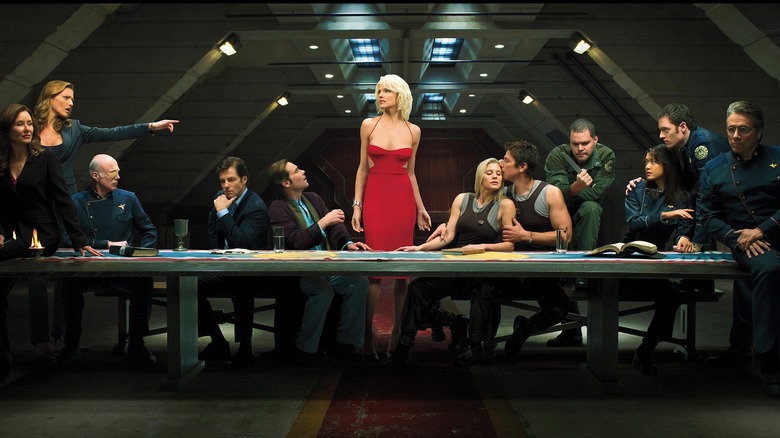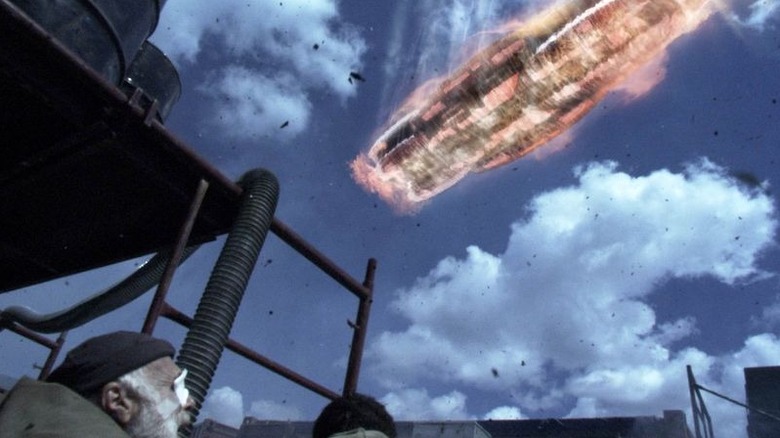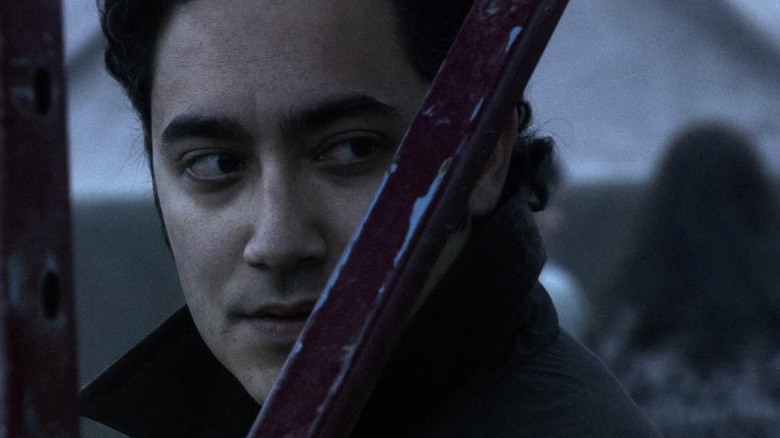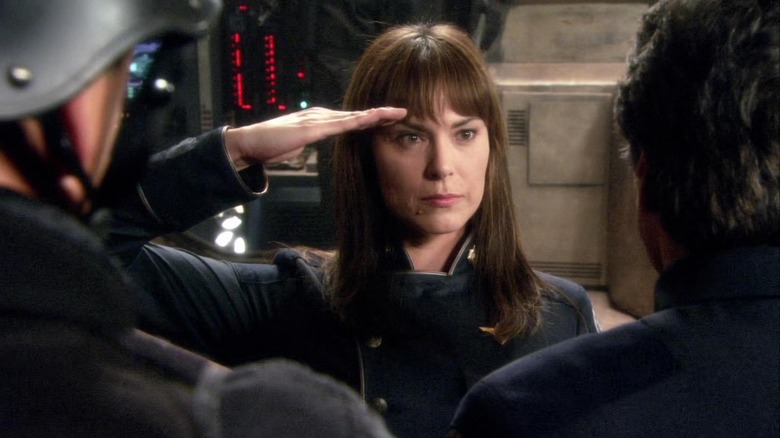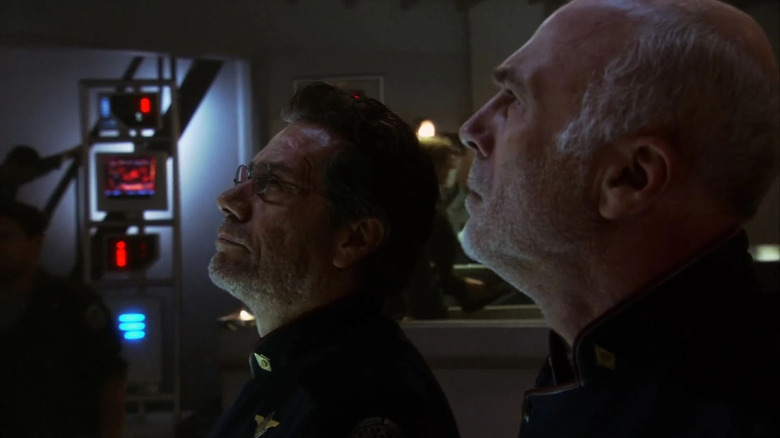Every Season Of Battlestar Galactica, Ranked
The reimagined "Battlestar Galactica" is one of the greatest and most ambitious science-fiction television shows ever aired. When "Galactica" begins, humanity is living on 12 colony planets named in tribute to the signs of the Zodiac: Caprica, Tauron, etc. About 50 years ago, mankind created robotic servants called the Cylons, who rebelled and waged war until an armistice.
When the series begins, the Cylons (who have upgraded into human-like forms) return and wipe out the 12 colonies. The 50,000 or so survivors flee in a spaceship fleet, guarded by a "Battlestar" warship, Galactica. Led by William Adama (Edward James Olmos) and President Laura Roslin (Mary McDonnell), the survivors search for the fabled 13th colony: Earth.
Co-creators Ronald D. Moore and David Eick rebooted the short-lived 1978 original "Galactica" by taking out the cheese in favor of drama and political resonance. Moore, who broke into TV writing on "Star Trek: The Next Generation," got to air his frustrations with the often too-safe writing on "Trek" by making "Battlestar Galactica."
On "Battlestar Galactica," characters died and usually stayed dead. (Unless they were lucky enough to be a Cylon who could download into a new body.) Characters were faced with difficult decisions and rarely got easy ways out, and the choices they made at those critical moments would have consequences.
Originally airing on the Sci-Fi Channel (later Syfy), "Battlestar Galactica" began with a two-part, three-hour pilot mini-series in 2003. Then it ran for four seasons/76 episodes (plus two TV movies) from 2005 to 2009. Efforts to make "Battlestar Galactica" spin-offs like "Caprica" didn't quite pan out, but the series itself was a definitive success. Yet any long-running TV show will have highs and lows. How do the four seasons of "Battlestar Galactica" rank from worst to best?
4. Season 3
"Battlestar Galactica" was not a show crafted with a firm plan ahead of time. That isn't to say that the writers were winging it. Take a look at Ronald D. Moore's series bible: there's a lot of detail about the characters and the world. But as for directions the story would go and how mysteries would be resolved, the show started out with only guidelines and possibilities. The writers asked questions of themselves and the audience, but they sought to find those answers on the journey instead of starting out with a planned destination.
The flaws of that approach show up with the cracks in "Battlestar Galactica" season 3. It's not bad, but it is the show's most aimless.
Now, season 3 opens with one of the show's highest highs. The four-part "New Caprica" arc features the humans, having settled on a new planet, living under Cylon occupation. The leads are plotting rebellion and escape from their occupiers, and the episodes are bleak and relentless for it. The season's fifth episode, "Collaborators," is a strong epilogue about the trial of humans who collaborated with the Cylons.
After that, though, the season sticks mostly to standalone stories where the supporting cast takes the spotlight. This approach leads to a few great episodes, like "Unfinished Business" (where the Galactica crew holds a boxing tournament to blow off steam), and "Dirty Hands" (about a unionization effort on one of the fleet's labor ships). But taken together, it feels like the show is slowing down as it struggles to cash the checks it wrote.
Season 3 also introduces the mystery of the "Final Five" Cylons, whose identities are revealed in the season finale, "Crossroads." No spoilers, but this story and its answers wound up being more trouble than they were worth.
3. Season 4
The final season of "Battlestar Galactica" is probably the series' most divisive and controversial. After the more episodic approach of season 3, season 4 went back to heavy serialization. The writers had finally cracked their grand plan and every episode was a puzzle piece of it. The structure comes together well, but not everyone was satisfied with how each of the myriad mysteries were wrapped up.
Since the mini-series, there'd been hints and premonitions of something supernatural in "Galactica." The Cylons worshipped a God and claimed his will guided everything. There was plausible deniability — until season 4, when the hand of god started more visibly intervening. Impossible events that could only be caused by fate happened, and it became clear the characters were players in a game that God and his angels had played many times before.
Not every fan liked this unambiguous shift, and the series finale "Daybreak" is controversial. I'll admit, my feelings on season 4 are a little anomalous. I think some of the story decisions were puzzling or misguided, but I was still locked in and enjoying myself for the whole season.
"Battlestar Galactica" season 4 is a season greater than the sum of its episodes. The ideas are all executed as well as they could be, it's just a matter of taste if you liked those ideas. Except for the one story everyone likes: the mutiny arc, which plays out in episodes "The Oath" and "Blood on the Scales." When I spoke to writer Mark Verheiden about this arc, he noted the writers' room held back on this story until the very end because, realistically, a mutiny needed an enormous breaking point to happen. Waiting until the tail end of the series, when the characters had endured despair after bottomless despair, for an uprising was absolutely the right call.
2. Season 2
When I think back on "Battlestar Galactica," it's easier to remember the highs than the lows. Season 2 is the season that benefits the most from this in memory.
Unlike the first season, season 2 of "Battlestar Galactica" was broken into two, ten-episode halves that aired separately. (The season premiered in July 2005, went on hiatus in September, then returned in January 2006.) The first half is above reproach. It sustains the momentum from the season 1 cliffhanger with a seven-episode-long running storyline. The front half ends with "Pegasus," one of the show's very best episodes. The fleet discovers another Battlestar survived the Cylon attack, but its commander Admiral Helena Cain (Michelle Forbes) should not be trusted.
Then, season 2 stumbles a bit in the back half, falling into a very "Star Trek"-like pattern of some underwhelming episodes. Coming off of the heavily serialized first half, the second half resolves the Pegasus plot in opening two-parter "Resurrection Ship" and then shifts to standalone episodes.
"Scar" (about Starbuck dogfighting a determined Cylon raider) is a strong episode and "Downloaded" gives an inside look into the Cylons. Conversely, "Epiphanies" cures President Roslin's cancer with the sort of technobabble magic the show had promised not to use, and "Black Market" is often held as one of the show's worst episodes.
However, the season ends strong with the two-parter "Lay Down Your Burdens." As the presidential election between Roslin and Baltar looms, the fleet discovers an inhabitable planet. They must decide whether to settle there or keep searching for the promised land of Earth. The season 2 cliffhanger is somehow even more gutsy than season 1's. This all means that the few poor episodes of "Battlestar Galactica" season 2 are remembered as mere bumps in an overall satisfying experience.
1. Season 1
I think chunks of later "Battlestar Galactica" seasons are better than the first season: the Pegasus, New Caprica, and the mutiny arc are the series' absolute best. But taken as a whole package, the first season of "Battlestar Galactica" is the tightest and most consistent. It's also the shortest with only 13 episodes (or 15, counting the mini-series). Due to that, the writers and crew were able to refine each episode to be its strongest self.
There's not a single bad episode in "Battlestar Galactica" season 1. The writers and actors found their footing instantly, no doubt because they got to work out the usual pilot kinks on the mini-series rather than in the season itself.
Even if "Battlestar Galactica" sometimes struggled with the big picture, it never struggled with depicting who its characters were and what their daily lives and conflicts were like. The very first episode, "33" is about as exemplary and confident as a series premiere can be. The Galactica and her fleet are on the run from the Cylons, who appear every 33 minutes and force the fleet to "jump" faster than light every time. When the episode begins, the chase has been going on for days and the crew is near breaking point.
Even the season's weakest episode, "Tigh Me Up, Tigh Me Down," is a fun experiment. The writers were experimenting with how blatant the show's comedy could be, and the results are truly funny even if the show would never get so silly again.
The "Battlestar Galactica" mini-series burned with promise, and season 1 proved the team could deliver on it.
